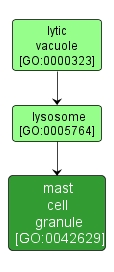GO TERM SUMMARY
|
| Name: |
mast cell granule |
| Acc: |
GO:0042629 |
| Aspect: |
Cellular Component |
| Desc: |
Coarse, bluish-black staining cytoplasmic granules, bounded by a plasma membrane and found in mast cells and basophils. Contents include histamine, heparin, chondroitin sulfates, chymase and tryptase. |
|

|
INTERACTIVE GO GRAPH
|














